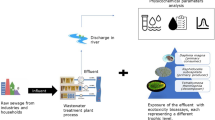Abstract
Whole effluent toxicity (WET) tests, with Daphnia magna and Selenastrum capricornutum, were introduced to evaluate the biological toxicities of effluents from the wastewater treatment plants (WWTPs) in Korea. In WET tests of WWTPs effluents, 33.3% (33/99) for D. magna and 92.6% (75/81) for S. capricornutum revealed greater than 1 toxic unit (TU), even though all the treatment plants investigated were operating in compliance with the regulations, as assessed using conventional monitoring methods (i.e., BOD and total concentration of N or P, etc). There were only minor differences in toxicities according to the types of influents (municipal and agro-industrial) in all treatment plants. However, the effluents treated by an activated sludge treatment process were found to exhibit significantly lower toxicity than those treated by rotating biological contactor (RBC) and extended aeration processes. The seasonal variations in the toxicity were lower in the summer compared to winter, which may have been due to the rainfall received to the sewage intake system during the former period. The impact of WET on river water was also investigated based on the discharge volume. At sites A and B, the total impact of toxicity to stream and river waters was observed to be 70.9% and 90.4% for D. magna and S. capricornutum, respectively. The other four small treatment plants (sites F, G, H and I), with relative discharging volumes between 0.001 and 0.002, contribute less than 1% to the total toxicity.
Similar content being viewed by others
References
Chapman, P. M. (2000). Whole effluent toxicity testing-usefulness, level of protection, and risk assessment. Environmental Toxicology and Chemistry, 19, 3–13.
Cœurdassier, M., de Vaufleury, A., Crini, N., Scheifler, R., & Badot, P. M. (2004). Assessment of whole effluent toxicity on aquatic snails: Bioaccumulation of Cr, Zn, and Fe, and individual effects in bioassay. Environmental Toxicology and Chemistry, 24, 198–204.
Oris, J., & Klaine, S. (Eds.) (2000). Annual review: Whole effluent toxicity testing. Environmental Toxicology and Chemistry, 19, 1–256.
Sarakinos, H. C., Bermingham, N., Paul, A., White, J. B., & Rasmussen, J. B. (2000). Correspondence between whole effluent toxicity and the presence of priority substances in complex industrial effluents. Environmental Toxicology and Chemistry, 19, 63–71.
Tonkes, M., Graaf, P. J. F., & Graansma, J. (1999). Assessment of complex industrial effluents using a whole effluent toxicity (or WET) approach. Water Science and Technology, 39, 51–61.
U.S. Environmental Protection Agency (1993). Method for Measuring the Acute Toxicity of Effluents and Receiving Waters to Freshwater and Marine Organisms, Environmental Monitoring Systems Laboratory, Cincinnati, OH, EPA/600/4-90/027F.
U.S. Environmental Protection Agency (2004). National Whole Effluent Toxicity (WET) Implementation Guidance under the NPDES Program, EPA 832-B-04-003.
Author information
Authors and Affiliations
Corresponding author
Rights and permissions
About this article
Cite this article
Ra, J.S., Kim, H.K., Chang, N.I. et al. Whole Effluent Toxicity (WET) Tests on Wastewater Treatment Plants with Daphnia magna and Selenastrum capricornutum . Environ Monit Assess 129, 107–113 (2007). https://doi.org/10.1007/s10661-006-9431-2
Received:
Revised:
Accepted:
Published:
Issue Date:
DOI: https://doi.org/10.1007/s10661-006-9431-2




